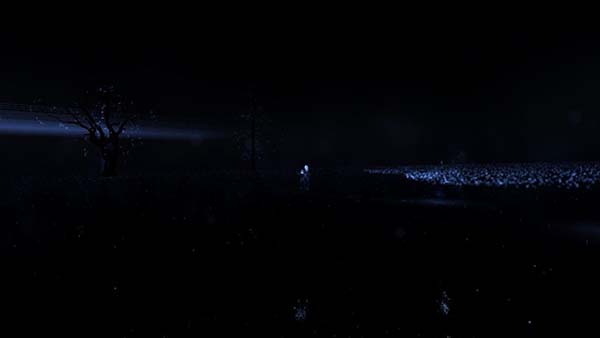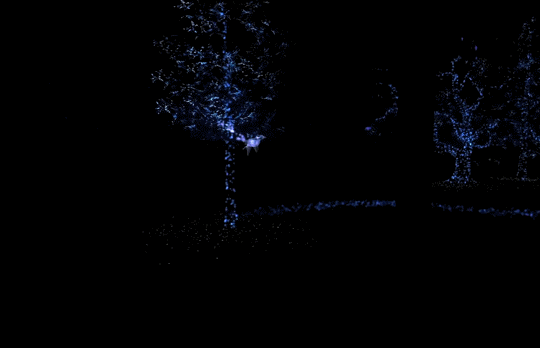Editor’s Note: This is the fifth post in the series on Disabling Technologies
Can technology convey experiences that are not our own, ones we can at the most imagine experiencing from a first person perspective? Furthermore, can technology help us understand the multisensory and deeply emotional qualities of such experiences? Central to this post is the consideration of how the Virtual Reality (VR) documentary Notes on Blindness may enable us to experience a ‘world without images’. I explore these questions through touching upon the problem of individual experience contra the universal. Indeed, if there is no such thing as a “universal” experience of blindness (Cupitt 2017; Hull 1990; Sacks 2005), and if VR experiences are also highly individualized (Aardema et al 2010), is there still value to be found in the personal experience? In an auto-ethnographic description of my experience with Notes on Blindness, I will focus mostly on my bodily sensations, changing emotions and how I went about “looking for my legs” in a VR.

Screenshot taken from the first chapter of Notes on Blindness
Looking for My Legs
Notes on Blindness is a multimedia project (a short film and a VR project) that borrows its inspiration from John M. Hull’s autobiographical sound notes (see also Hull 1990). At the age of thirteen, Hull was diagnosed with cataracts, a clouding of the lens in the eye. He went through a number of surgeries that initially restored his sight. However, these procedures led to retinal detachment and caused Hull to eventually lose his sight at the age of 48. Hull’s autobiographical notes recount his memories and experiences of acquired blindness, culminating in what he has described as “deep blindness.” In the VR project, chunks of these sound notes are used as a storytelling device that guides the participant along Hull’s journey and into his perceptual reality.
I first experienced Notes on Blindness at DocLab 2016, a branch of the annual International Documentary Festival Amsterdam (IDFA). The festival’s online program stated that VR would “allow us to ‘see’ how we can experience the world without images, emotionally and cognitively, in a marvelous way.” VR experiences indeed prompt viewers to feel as if they are inside another ‘world’ or ‘space’. From my perspective however, the promise of being able to experience a ‘world’ without images seemed curious given the predilection for vision in VR systems. Upon ending my VR journey, I puzzled over the means by which VR had raised my awareness. In other words, how had this VR succeeded in letting me “see” that blindness can also be looked upon as an existential enrichment? I felt that the technology had played tricks on both my mind and my body. These tricks were most notable in the third chapter of the VR account, which goes deeper into feelings of panic.
On Panic: Body and Mind Engaged
In the first two chapters of Notes on Blindness I gradually acclimate to the VR space. By Chapter 1, I am relatively at home with the feeling of being at the edges of a dark field, and as Hull narrates a story of “the nature of acoustic space”, I witness small glowing lights steadily form the boundaries of an observable space in concert with the sound of his voice. Observing these faint lights, I wonder at the paradox of being able to see what it is like to be blind.

Small glowing lights forming the boundaries of the VR space. © Alessio Casella
The darkness and pin-pricks of light in Chapter 3 make me feel as if I am being thrown into a galactic outer space. Rather than having the impression of being on the outside, largely observing a world I do not really inhabit, I move right into the middle of a vast and dark space. Surrounding me is a black void and flickers of glowing stardust whirl around me like visible plumes of air that crawl ever closer to my skin until I feel fully closed in. Panic strikes. How long have I been here? “Look at the blue steps on the ground and make them disappear to continue,” white text instructs at the edges of my range of vision, but as I look to the left, to the right, in front of me and behind, I notice that there are no blue steps to be found. Even more so, there is no such thing as a ‘ground’. I am floating and my body seems to have abandoned me- that is, I can’t see my body when I glance down looking for the promised footsteps. My senses go into overdrive. I feel hyper-alert and visually aware. Indeed I may not be able to see it but I feel my body acutely. Part of this is increased awareness is being able to feel my heart beating faster and faster and my breathing quicken. Panic becomes mixed with a feeling of bewilderment. If I ‘rationally’ know that I am in a Virtual Reality, in other words inside an illusionary world, why are my sensations so viscerally real? Perhaps I am not seeing what it is like to be blind, but feeling it?
Becoming Blind and the Dissolving Body Image
Later, reading Hull’s autobiography Touching the Rock, I came across a paragraph that described a sensation mirroring the one I had in the chapter on panic. In February 1984, Hull notes that ‘the lack of a body image’ makes his struggles with depression worse:
“The fact that one can’t glance down and see the reassuring continuity of one’s own consciousness in the outlines of one’s own body (…) I am dissolving. I am no longer concentrated in a particular location, which would be symbolized by the integrity of the body.” (Hull 1990: 56)
While experiencing Notes on Blindness, I too felt as if I was dissolving, having lost both my body and a solid ground. Swirling around in an open space, it seemed in fact as if I had lost my legs. The phenomenon of “dissolving legs,” in other words, of having no visual access to your legs, is a common issue in the context of VR. It is the visual absence of legs that is thought to be responsible for ‘motion sickness’ or ‘cyber sickness’ (Aronsson, 2016; Bonasio, 2015), as well as dissociation (Aardema et al, 2010). These side effects are theorised to be, among other things, the result of a ‘mismatch’ between different types of sensory input (Bonasio, 2015; Searles 2016; Jáuregi-Renaud 2015: 1). VR developers hope that once the image of the body is reintroduced, such perceptual glitches will cease to exist and the immersive experience of VR will be intensified (Dolezal 2009; Gleason 2016). Whereas many VR scientists seem to regard the absent image of the body as a hindrance to full immersion and presence in VR (Dolezal 2009; Gleason 2016), Notes on Blindness cleverly capitalizes upon this alleged technological deficiency in order to portray one significant aspect of Hull’s experience of becoming blind.
Chapter 3 of Notes on Blindness is not the only moment in which the absent body image is so strongly emphasized. If you, for some reason, want to ‘leave’ a chapter and return to the main menu, you can do this (as you will find announced by ‘on-screen’ text) by “look[ing] at the text at your feet”. Doing this will however make you feel somewhat ‘dismembered’ (Favero forth), as these instructions make you firmly aware of the fact that there are no feet to be looked at in VR ‘space’. When it comes to VR experiences in general, the question remains whether you really leave your body ‘at the door’ (Penny 1995, in Hansen 2004: 164) upon entering a VR space.
Reconsidering Blindness: on Visual Absence and Bodily Presence
While I did not take the IDFA’s promises literally, my perception of and attitude towards blindness did change somewhat after having been “in” this VR. Frankly speaking, I did rely on visual perception in exploring the chapters of Notes on Blindness and for this reason alone I may not have seen what a world without images could be like. However, I did momentarily feel as though I was introduced to a world beyond sight because I too was lacking a “body image” (Hull 1990: 56). While the world around me was, however dark, still visually perceived, when it came to perceiving my body I was driven to let my eyes rest. Instead I relied on my proprioceptive senses. This bodily experience in fact made me feel that seeing is not the only way of “being-in-the-world” (Heidegger 1927). As a “VR experience,” Notes on Blindness has by some means raised my awareness: instead of being a mere disability or impairment, blindness is in fact shown to be “a dark, paradoxical gift, and an entry (…) into a new and deep form of being” (Sacks 1990: xiv).
References
Dolezal, L. 2009. The Remote Body: the Phenomenology of Telepresence and Re-embodiment. Human Technology: an Interdisciplinary Journal on Humans in ICT Environments, 52(2), 208-226
Favero, P. Forthcoming. To Swallow or to get Swallowed, this is the Question: on Viewing, Viewers and Frames in the Context of “New” Images. In Filitz, T (ed.) An Anthropology of Contemporary Art. London: Bloomsbury
Gleason, S.P. 2016. Technology and the Not-so-Stable Body: “Being There” in the Cyborg’s Dilemma. Journal for Virtual Worlds Research, 9 (2), 1-16
Heidegger, M. 2010 [1927]. Being and Time. Albany: State University of New York Press
Hansen, M. B. N. 2004. What’s Virtual about VR? “Reality” as Body-Brain Achievement. In Hansen, M.B.N. New Philosophy for New Media (pp.161-195). Cambridge/London: The MIT Press
Hull, J. 2013 [1990]. Touching the Rock. London: SPCK
Sacks, O. 2005. The Mind’s Eye: What the Blind See. In Howes, D. (ed.) Empire of the Senses. The Sensual Culture Reade (pp. 25-42). Oxford/New York: Berg
Sacks, O. 2013 [1990]. Foreword. In Hull, J. Touching the Rock (pp.xi-xvii). London: SPC

2 Comments
Here’s another piece on VR & the notion of empathy- they also mention Notes on Blindness:
“Maybe contemporary VR needs to let go of empathy as a goal and start using it as a technique. Notes on Blindness, made as a VR accompaniment to a film of the same name, literally creates a visual language that emulates how someone with heightened aural senses perceives the world. In one section of this piece, the world appears and disappears around you, leaving visible only objects that are currently emitting a sound. It conveys an instability of environment that is deeply unfamiliar to sighted people, while still using a visual medium to do it.”
Read the full article here:
https://www.buzzfeed.com/ainsleysutherland/how-big-tech-helped-create-the-myth-of-the-virtual-reality?utm_term=.jioZqBNkn#.rdJOdoYKJ
Great article. This reminded me of a project a group of Swedish researchers conducted where they used Virtual Reality to elicit empathy and understanding among students who took part in or observed bullying in schools. The VR film puts you as the “viewer” in the role of the student being bullied. The idea is that the “viewer” will realise what it is like to be bullied and therefore be less likely to act as a bully themselves.
https://www.youtube.com/playlist?list=PLSHcVfKvOzQMUHQmuozMldaDMT6Zb2lMx
I tested the film at a VR festival in Sweden last year and it brought back *memories* of school but I was dubious about the power of VR to elicit empathy.